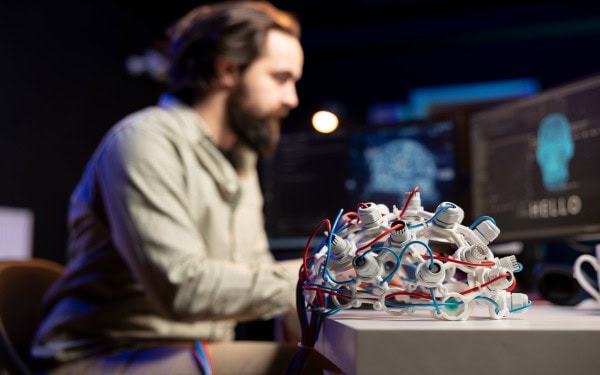Neuroplasticity, the brain’s remarkable capacity to adapt and reorganize, plays a crucial role in our lifelong ability to acquire new skills and knowledge. This article explores the mechanisms of cerebral cortex adaptation and their implications for education, therapy, and personal growth.
Understanding Brain Plasticity
The brain’s ability to form new neural connections and modify existing ones in response to experiences, environmental changes, and the acquisition of new information is a fundamental aspect of human cognition. This dynamic process, known as neuroplasticity, occurs throughout our lives, challenging the long-held belief that brain structure is fixed after childhood. At the cellular level, neuroplasticity involves several key processes:
- Synaptic plasticity: The strengthening or weakening of connections between neurons
- Neurogenesis: The formation of new neurons, particularly in the hippocampus
- Axonal sprouting: The growth of new nerve endings to form new synaptic connections
These mechanisms allow the brain to rewire itself in response to new experiences, forming the foundation of memory formation and skill acquisition. Researchers distinguish between two main types of brain adaptability: structural plasticity, which involves changes in the brain’s physical structure, including the growth of new neurons and synapses; and functional plasticity, which refers to changes in the brain’s functional organization, such as the reassignment of neural pathways to different tasks. Both types play crucial roles in cognitive development and recovery from brain injuries.
Brain Adaptability Across the Lifespan
While neural plasticity is most pronounced during early childhood, the brain retains its ability to change and adapt throughout adulthood. This has significant implications for education, skill development, and cognitive health as we age. Early childhood is characterized by heightened brain adaptability, with critical periods for the development of various skills. Language acquisition is particularly sensitive in the first few years of life, while visual processing undergoes crucial development in the first months after birth. Emotional regulation also sees significant development during early childhood.
While these critical periods offer optimal windows for cognitive growth, research shows that adult brains can still acquire new skills and knowledge, albeit often at a slower pace. This adult brain plasticity supports the acquisition of new abilities, recovery from brain injuries, and adaptation to sensory changes (such as learning to interpret sounds after cochlear implant surgery). Understanding adult brain adaptability has led to new approaches in education and therapy, emphasizing the brain’s lifelong capacity for change and growth. This knowledge has profound implications for how we approach personal development throughout our lives.
Harnessing Brain Plasticity for Cognitive Growth
Educators, therapists, and individuals can leverage neuroplasticity to enhance cognitive development and personal growth. Several key factors influence the brain’s flexibility and can be used to promote mental agility and learning capacity. Exposure to stimulating environments and varied experiences promotes brain plasticity. This includes:
- Engaging in novel activities and developing new skills
- Participating in intellectually stimulating discussions and debates
- Learning a new language or musical instrument
Such experiences create new neural pathways and strengthen existing ones, enhancing cognitive flexibility and mental acuity.
Regular physical activity has been shown to promote neuroplasticity through multiple mechanisms. Exercise increases blood flow to the brain, stimulates the production of growth factors that support neuronal health, and enhances the formation of new synapses. These effects not only improve overall brain health but also enhance cognitive function and memory formation. Studies have shown that aerobic exercise, in particular, can increase the volume of the hippocampus, a brain region crucial for learning and memory. Even moderate physical activity, such as brisk walking for 30 minutes a day, can have significant positive effects on brain health and mental performance.
Practices like mindfulness meditation have been found to induce adaptive changes in the brain, leading to improved attention and focus, enhanced emotional regulation, and increased gray matter density in regions associated with cognitive processes and memory. These findings suggest that mental training can have tangible effects on brain structure and function. Regular meditation practice has been associated with changes in the prefrontal cortex, which is involved in executive functions such as decision-making and self-regulation. Additionally, mindfulness practices have been shown to reduce activity in the amygdala, a brain region associated with stress and emotional reactivity, potentially improving overall cognitive performance and well-being.
Implications for Education and Therapy
Understanding neuroplasticity has profound implications for educational practices and therapeutic interventions. By leveraging the brain’s adaptive capabilities, educators, and therapists can potentially enhance learning outcomes and treatment efficacy across various domains. Educators can harness brain adaptability by providing diverse and challenging experiences, incorporating multisensory teaching methods, encouraging active problem-solving, and emphasizing the importance of practice and repetition in skill acquisition. These approaches tap into the brain’s adaptive capabilities, potentially enhancing cognitive outcomes across various subjects and skills. For instance, project-based learning approaches that engage students in complex, real-world problem-solving can stimulate the formation of diverse neural connections. Similarly, incorporating arts and music into the curriculum can enhance overall cognitive function and promote creative thinking by engaging multiple brain regions simultaneously.
- Cognitive rehabilitation for brain injury patients
- Treatment of developmental delays and learning disorders
- Management of age-related cognitive decline
- Development of new strategies for mental health treatment
- Motor skill recovery in stroke patients
By targeting specific neural pathways and promoting adaptive changes, therapists can help patients overcome challenges and improve their quality of life.
Future Directions in Brain Plasticity Research
As our understanding of neuroplasticity grows, researchers continue to explore its potential applications and implications. Dr. Christian Beste, a leading neuroscientist in this field, emphasizes the importance of translating research findings into practical applications. ‘The more we learn about the brain’s capacity for change, the better we can design interventions to enhance cognitive growth and recovery,’ says Dr. Christian Beste. ‘Our challenge now is to develop targeted approaches that can effectively stimulate beneficial adaptive changes in specific populations.’
Christian Beste and his colleagues are currently investigating how neurofeedback and non-invasive brain stimulation techniques can be used to enhance brain plasticity in both healthy individuals and those with neurological disorders. Their work holds promise for developing new therapeutic approaches and cognitive enhancement strategies.
As research in brain adaptability continues to advance, it offers exciting possibilities for enhancing human potential throughout the lifespan. By understanding and harnessing the brain’s remarkable flexibility, we can develop more effective educational strategies, therapeutic interventions, and personal growth practices. The field of neuroplasticity reminds us that our minds are not static, but dynamic, ever-changing networks capable of growth and adaptation at any age. This knowledge empowers us to take an active role in shaping our cognitive health and abilities, opening up new avenues for lifelong development and personal enhancement.







